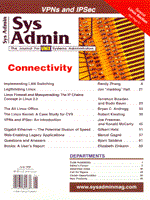
Editor's Forum
From an editorial sense, we define connectivity rather broadly: hardware, software, and services that provide links, usually from a remote location, between people and the applications they want to run. Most systems administrators will have similar definitions for the term, and will find it useful from time to time to go through a diagramming exercise as a means of seeing where they are presently, and where they are headed connectivity-wise. If you do this, and save your diagrams, you see an interesting trend for the circles (or other shapes used to depict the elements) to increasingly overlap or converge. Additionally, you will see indicators of other elements in the system that will require different types of administration. On the hardware side of connectivity, we include modems (and pools thereof) for traditional remote access using POTS lines - the Plain Old Telephone System that is virtually everywhere. In today's Internet-centric computing world, however, POTS and Internet forms of connectivity are converging. We may still use modems at the client end-point to establish the connection, but often the physical layer of the connection is also part of our network, either local or wide area. For example, the client may dial into a remote POP site for our ISP, and establish a virtual private network (VPN) connection back to the systems in the office. And, while the host-side modems once connected directly to the serial ports on the host, now the modems are often connected to the LAN, thus giving the remote user a choice between various hosts. Currently, the client side of the connection is still via POTS lines, either to the modem pool or the ISP's POP site, and is limited to a maximum speed of 56Kbit/sec. That will likely change in the future, however. Bandwidth-hungry mobile users will motivate telecommunications vendors (and hotels) to find ways of offering roving ISDN or xDSL-style services (for an enhanced fee, of course). After all, once IPv6 is fully implemented, why shouldn't each laptop, hotel room, and phone booth have its own fixed IP address? The software element of the connectivity equation still involves both traditional telecommunications software and terminal emulation. Terminal emulation, however, is giving way to more network-centric forms of communication, so users can establish links that provide support for both graphical and character-based interfaces. For example, as more sites move toward providing browser-based interfaces to both present-day and legacy applications, the protocols supported by the physical link need to be more sophisticated. This fact provides additional impetus to the Telcos to provide higher-speed connections. In five years or so, today's 56K modems will seem as antiquated as 1,200bps modems do now, and terminal emulation key mapping will be virtually unseen. Connectivity services now comprise POTS lines and ISP connections, which, in turn, use POTS lines in addition to dedicated networks. Increasingly, however, POTS lines are giving way to higher-speed Telco lines, such as ISDN and xDSL. Availability of such services acts to further cloud the distinctions between connectivity and network. A system that I am currently reviewing for our sister publication, UNIX Review's Performance Computing, offers further evidence of this convergence of connectivity. The HP A-Class server includes a separate 10BaseT port, with an embedded Web server, to provide management access to the system's console port. Thus, real console-level administration can be performed from any global location through the use of a Java-enabled browser. There is no rocket science here - a terminal server box and a Web server machine of some sort could accomplish the same objective. The fact that HP is thinking in terms of Web-based systems management, however, is the interesting part. Why shouldn't we be able to manage our systems through our browser-enabled cell phone from a remote location - Tahiti, say? Now, that's connectivity!
Sincerely yours, |